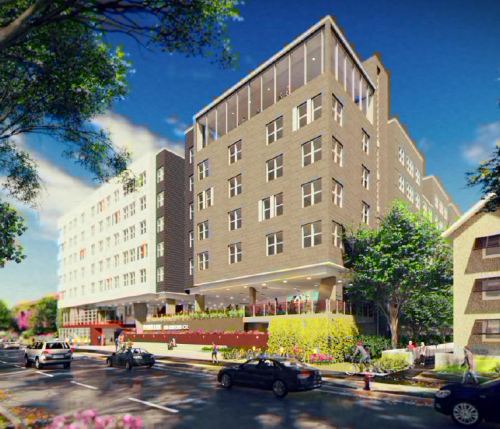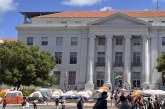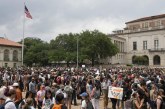
This time there would be no mistake. In May, the Planning Commission, while supportive of the Davis Live student apartments in general, was not able to recommend approval on a variety of grounds including concerns about a CEQA exemption, the affordable component and traffic and transportation studies.
This time, armed with a thorough explanation of not one but two grounds for CEQA and modifications to the affordable housing plan, increasing the percentage of units from 12 to 15, the commission would support recommendation on a 6-0 vote.
Staff proposed a modification to the General Plan Amendment which would limit the “very high density” designation to properties on the north side of Russell Boulevard “between State Highway 113 and Sycamore Lane.” This was done to avoid the approval of this project becoming precedent setting in terms of density.
The proposal is for a 71-unit, 440-bed housing project adjacent to existing student housing.
The project site is just over one acre in size and is located at 525 Oxford Circle. The site fronts Russell Blvd., across from the Orchard Park Apartments site, in the vicinity of the UC Davis campus. The site was previously developed with a two-story building that was occupied by the Sigma Nu fraternity.
The project continued to draw opposition from the manager of the adjacent property as well as some nearby neighbors on the grounds of too high a density.
Said Roy Benson, who manages the property next door, “I’m not against this proposal, but the size is just too much.”
The project also received pushback in the form of another letter from Patrick Soluri of Soluri Meserve. Mr. Soluri disparagingly wrote: “These eleventh hour tactics are contrary to the California Environmental Quality Act’s public disclosure requirements. This Commission should hold staff and project applicants to a higher standard of disclosure, particularly when following a project denial.”
The comments drew the ire of several commissioners.
Greg Rowe retorted, “I can’t help but saying, Mr. Soluri please stop. You’re becoming a nuisance. I think he’s becoming sort of like the CEQA version of an ambulance chaser. He’s interfering  with projects in the city that have been approved by the voters. So if you’re watching, please go back to Sacramento and leave us alone.”
with projects in the city that have been approved by the voters. So if you’re watching, please go back to Sacramento and leave us alone.”
Stephen Mikesell also took exception to the notion that city staff was using 11th hour tactics “when we’ve got letters coming in before the meeting.” He said, “So I guess one has to know 11th hour tactics, to identify them.”
Casey Lizon, representing SACOG (Sacramento Area Council of Governments), said that this project represents the Sacramento Blueprint, which “represents a regional sustainable growth vision for the six county region and is based on seven principles of development for that growth.”
She called out four principles in particular, even though she said the project supports all seven. She cited compact development (which promotes higher density), use of existing assets (which promotes infill and redevelopment), housing choice, and mixed-use development (building homes near jobs), as well as transportation choice.
On the whole, the public comments heavily favored the project. Despite the discussion occurring during the summer months, 10 students showed up to express support for the project and reiterate the need for student housing.
Andrew Claussen currently lives with four other people in a duplex that does not offer much in the way of space.
“High density projects are really what this city needs most,” he said. “Housing delayed is the same as housing denied. I appreciate your guys’ standards, but at the same time, the longer we wait to build high density things in this town, the worse this problem is going to get. As bad as it is already, I don’t think we can take it getting much worse.”
Sarah Dye, a post-doc, noting the experience of students, said, “The most difficult part of getting your degree should not be finding a place to live.”
Adam Hatefi added, “At the end of the day, it comes down to whether the values of our community are going to be to welcome those who come here to build their future or to not.”
He said, “The university builds when the city builds. If the city doesn’t build, then where are we going to end up?”
While Eileen Samitz spoke in favor of this project, she pushed back on the notion of shared responsibility. She pushed the students “to do equal advocating to their chancellor and their administration – because I haven’t heard any of that going on.”
Stephen Mikesell described himself as the Lone Ranger on this issue in May, “I was prepared to consider this in May. I thought there was sufficient information for us to act that. That was decidedly not the opinion of the rest of the commission.”
There was some exchange on issues of affordable housing and the tree lining. Now that the project went up to 15 percent affordable, the key issues were about double-occupancy and whether the affordable beds would be strictly double occupancy and the availability of the affordable units to families.
Mr. Soluri in his letter criticized the project, arguing that “the dormitory-style accommodations makes the point. The Project’s affordable beds are exclusively contained in double-up rooms inside larger four-to-eight bedroom apartments, with shared kitchens and bathrooms.” He adds that “there is no guarantee that a family could even share the same double-up bedroom, or even the same apartment.” He writes, “By the Project applicant’s own concession, these are not suitable family accommodations.”
The representative from Greystar Student Living responded, “Since we lease by the bed, a family would have to lease multiple beds within a unit to be able to hit those requirements laid out in our lease agreement.” He said, “There are situations where families can lease with us and do lease with us. I’d say that it’s rare that those things happen because of the by-the-bed leasing.”
He noted that it’s not an environment typically that families want to live in. He added, “It’s not precluded, it’s an option.”
Commissioner Darryl Rutherford asked whether “there could potentially be single-occupancy affordable beds?”
The representative responded, “It’s still being determined.”
Heidi Tschudin, Interim Community Development Director, added, “There may be some reconsideration by the applicant, but our materials do show double-occupancy.”
The project manager added, “We have anticipated double occupancy (for affordable beds), but again, we’re not final on that.”
Darryl Rutherford pushed, “I wonder if there’s a way you can strengthen this plan, because it seems very loose to me. I would like to see more of a commitment up front here, that it will happen.”
Commissioner Cheryl Essex was concerned that the plan called for the removal of a number of trees. While there are mitigations in place to replace and replant the trees, the arborist made it clear that the density meant that trees had to be removed and he further pointed out that the health of some of the trees called for their removal anyway.
Ms. Essex did get a concession from the developer to add large shade trees on the southeast and sourthwest corners of the property.
She told her fellow commissioners, “Because I see that the hackberries aren’t in very good health and some have structural problems, I’m okay with eliminating those as long as the city’s able to replant trees in some other location because it helps us get to the density we desperately need in this community to provide some affordable housing for these students.”
With that, the commissioner was largely in support of the project and Herman Boschken moved the staff recommendation with a few amendments and Cheryl Essex seconded it. It passed unanimously.
The project will now go forward to the city council for final consideration of approval.
—David M. Greenwald reporting






I’m glad to see the Plannjng Commission reached this decision.
I’d like to thank Lord Krishna and Rob Roy for this decision.
The bicycle parking design is apparently unchanged and is still horrid – a dozen movements from the street to one’s bed — easier to park a car than a bike. Before and at the public hearing on this before Council in late August, I plan to propose this the parking is moved to the front of the building within a larger re-orientation of the use of the first floor from housing for 71 private cars to housing for at least 24 people and 15 flex spaces (whoever needs ADA parking, with the remainder for carshare.)
I am pleased that the Planning Commission voted for more housing right next to campus, but am convinced that the market priced shared rooms will be way more expensive than same in many “mini-dorms” around town, which means that the discounted rooms and beds will also be unfavorably-priced.
Projects – or buildings or sections of projects – going forward all over town are still all individually-geared towards students or seniors or families or low-income people, an anachronism just like our town’s symbol, and in a way just as anti-egalitarian. I doubt that that we can change this sad gestalt until we have a new General Plan.
Just be sure this doesn’t interfere with the planned activation of Russel Boulevard.
This won’t be a nice place when the street is busy and filled with cars speeding to and from CA-113, the Peak Car Highway. (There’s also an outdoor screening area one floor up on the street side, but I digress….) The current plan for most of this space on the interior is car parking, even though cars enter from the other side of the building.